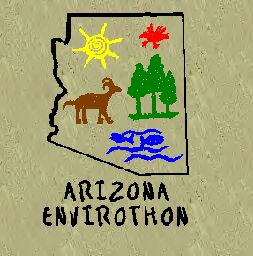Arizona Envirothon 2015
Urban/Community ForestryOther Web Links
The World Wide Web is a prolific source of information in this modern age. Most of the Web is not peer-reviewed, that is, read and checked by independent experts. Therefore, the web's information must be consumed with caution. It's always best to seek corroboration of information across multiple sources.
Here are several web sites that focus on the issues of Arizona forests and trees and on this year's Envirothon topic of alternative/renwable energy. Many of these web sites link to yet more web sites. The last one listed here is about general forest ecotones in Arizona; don't miss it.
Phoenix Urban Forestry
Phoenix AZ Tree and Shade Master Plan: Phoenix has a master plan. It's available from this web site, or directly as a pdf from here. Really good for ideas for Envirothon Urban Forestry.Arizona State Forestry
Arizona State Forestry Urban Forests Needs Assessment Survey: A good resource for more ideas on urban forestry. From Arizona State Forestry (not ASU Forestry).
Arizona Urban Tree Map Instruction Guide: Another resource from Arizona State Forestry. Practical ideas for actually establishing urban forests.I-Tree
I-Tree: USDA Forest Service product that provides urban forestry analysis and benefits assessment tools.Urban Forestry Links from National Envirothon
- List of sources on urban forestry from National Envirothon: A starting point for info on this year's focus theme of urban forestry.
On-line guides to important trees of Arizona
Note: You should be able to observe and describe tree specimens. Namely, describe the leaves (broad or needles, how long, how many needles per group), fruit (flowers or cones, scales, size), and bark (color, thickness, platy). Wikipedia on-line guides below are better than nothing, but a good basic tree guide for this is the "Golden Guide to Trees of North America."
- Douglas-fir: A major species of Arizona's Rocky Mountain mixed conifer forests.
- White fir: A lesser, but still important species of Arizona's Rocky Mountain mixed conifer forests.
- Quaking aspen: The crowd favorite of Arizona's subalpine forests.
- Fremont cottonwood: A common deciduous hardwood along Arizona's natural streams (riparian corridors).
- Arizona sycamore: Another common deciduous hardwood along Arizona's natural streams.
- Alligator juniper: An aptly named conifer in Arizona's Madrean woodlands.
- Velvet mesquite: A dominant legume (nitrogen fixer) tree of the Sonoran desert.
- Arizona white oak: An evergreen oak of Arizona's Madrean woodlands.
- Gambel oak: A deciduous oak of Arizona's Rocky Mountain ponderosa pine forests.
- Ponderosa pine: The dominant species of Arizona's Rocky Mountain ponderosa pine forests (what's left of it after the 2002 and 2003 fire seasons).
Some Arizona Forest Ecology Sites
Laboratory of Tree-Ring Research, University of Arizona
- Ecology of Southwestern Ponderosa Pine Forests: This page is comprehensive, but cruise through it and focus on:
- Why ponderosa pine is so important in Arizona.
- The natural fire regime of ponderosa pine and how current fire patterns are different.
- Other disturbance ecologies of ponderosa pine forests.
- Southwestern Sky Island Ecosystems: This youtube video details the biological diversity found in Arizona's so-called Sky Islands. Concentrate especially on the changing forest types with changing elevation.
- Biodiversity: What is this thing biodiversity and why do people worry about it? How might Arizona forests contribute to or detract from biodiversity? This web site is from the highly regarded American Museum of Natural History.
- Forest Fire Management in Arizona: Wildland fire is a dynamic process in Arizona's forests, including in some cultural landscapes that are built essentially right within fire-prone forests. Cruise this suite of web sites to learn about current and past fire patterns in Arizona and strategies and issues of restoring wildland fire to Arizona's forests. (Note: pdf files in this site are protected with a different password from the rest of this Arizona Envirothon site; check with Paul if you need the password.)
AZ Envirothon Forestry Links Home
Scientific Articles Newspaper Articles Other Web Links
Arizona Envirothon National Conservation Foundation Envirothon
Tucson, Arizona 85721 USA
Main Office: (520) 621-1608, Fax: (520) 621-8229
Comments to Paul Sheppard: sheppard @ ltrr.arizona.edu
Copyright © 2002-2015 Laboratory of Tree-Ring Research, University of Arizona
Revised — January, 2015
